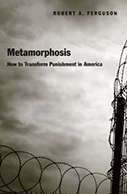Metamorphosis: How To Transform Punishment In America

Author: Robert A. Ferguson
Publisher: New Haven, CT; London: Yale University Press, 2018. 288p.
Reviewer: Sam Bieler | October 2018
Criminal justice reformers can claim many advantages in their struggles, but few would suggest the rhetoric of crime and punishment stands in their favor. More than forty years and countless political campaigns into America’s interminable wars on drugs and crime, the language of law and order continues to be a force for the status quo. In Metamorphosis, Robert Ferguson seeks to understand why language is the enemy of reform and how it could be an ally. The book is ambitious. It promises to not only reconsider the language Americans use to punish but the very rationale for punishing. The approach is unique, melding prisoners’ self-described experiences with a wide-ranging review of philosophy and literature. Too often, however, the discussion of policy and theory feels incomplete.
Metamorphosis harks back to George’ Orwell’s belief that language can corrupt thought. Today, Ferguson argues both judicial and public rhetoric have been tainted by a distaste for those incarcerated. This contemptuous language has poisoned our ability to punish fairly and made the traditional theories of punishment, incapacitation, rehabilitation, deterrence, and retribution, entirely too punitive. Moreover, the way we speak about these theories has made them inadequate to the task of helping the punished return to society.
In support of this argument, Ferguson musters a fascinating array of sources. Letters from prisoners, court decisions, the musings of philosophers, and even the tales of Greek and Roman myth are marshalled to urge the reader to reconsider how the current theories of punishment fall short.
Metamorphosis shines when dissecting and connecting the language of this unusual set of materials. In the second chapter, “Linguistic Tangle,” Ferguson takes apart the words of the Supreme Court’s prisoners’ rights decisions with surgical precision. In Farmer v. Brennan and other cases, he shows how the court uses imprecise language to strip rights away from inmates. For example, to find a prison administrator liable, risk that is “substantial” must also be “excessive”; to have “sufficient culpability” one must show “deliberate indifference.” As Orwell might have said in On Politics and the English Language, the mass of adjectives and adverbs fall on the legal standard “like soft snow, blurring the outline and covering up all the details.” By defining the prisoners’ rights in such vague terms, Ferguson argues that law protects and empowers prison guards and officials while permitting the abuse of those in their care.
Having pulled apart the language of the law, Ferguson then reaches into literature. His goal is to understand how the description of punishment influences its infliction. For this, he begins in the world of myth, exploring how the ancient Greeks and Romans, and in particular, the poet Ovid, described the act of punishment from the perspective of the ancient gods. Metamorphosis sees parallels between the Greek and Roman gods, who punished with impunity and without limitation, and the American prison system, which, freed from legal strictures and bereft of any limiting instinct in its theories of punishment, has the ability to do the same.
To explore the arbitrary nature of the American correctional experience, Ferguson draws on the personal experiences recounted from the hundreds of letters sent to him by prisoners. This is the book’s second great strength. Connecting the stories of myth and the language of the law to the actual indignities suffered by prisoners prevents a book about myth and theory from feeling overly academic and humanizes the stakes of this issue. The interweaving of these prisoners’ experiences and ancient myth is an altogether unique idea and, even if the synthesis sometimes feels difficult to follow, Ferguson should be commended for the ambitious attempt.
This investigation of law and myth leads to Ferguson’s plea for a new theory of punishment, one that focuses on human development instead of the infliction of harm. This is not, in Ferguson’s telling, a return to rehabilitation. The theory of rehabilitation implies a return to correct behaviors that the incarcerated previously possessed. Metamorphosis questions whether, given the socioeconomic inequities of American society, the incarcerated were every truly given the chance to obtain the qualities that prison rehabilitation seek to “restore.” Instead, Ferguson pushes for a theory of development, which promises to provide something new to those incarcerated. Education is key and chapter eight focuses on its centrality to this new theory of punishment. Metamorphosis’ ultimate goal is to use this new idea to displace retribution as the dominant theory of punishment. However, in its rush to propagate the new, Metamorphosis sometimes forgets there is still value in the old.
If Metamorphosis’ greatest strength is its willingness to explore new sources of thought, its greatest weakness is its sparse treatment of the ideas of prior criminological theorists. This is a dangerous charge to make at a time where the literature reviews of peer reviewed articles frequently sound almost liturgical in their repetitions of names and facts. However, when Ferguson makes a broad claim, for example, stating that current theories of punishment “tell us nothing about the degree of punishment that should be inflicted” a reader might justifiably ask whether two-hundred odd years of criminology and a few thousand years of moral philosophy have really left us so bereft of ideas.
The answer is no. Ferguson argues that retribution accepts no limiting principle in the degree of punishment it doles out, but many in the field would disagree. Professors like Paul Robinson and Shon Hopwood have done important work empirically assessing how both the public and judges conceive of the limitations retribution could impose on punishment. In 2016, retributive theory met practice when the Sixth Circuit Court of Appeals upheld federal judge James Gwin’s use of juror surveys of appropriate sentences as a tool for moderating the severity of a sentence. Judge Gwin proffered ascertaining the appropriate level of retribution as his rationale for using these surveys.
This a small sample of the work being done on retribution but enough to suggest that the theory of retribution deserves more exploration that Ferguson gives it. To engage with these ideas and find them lacking is one thing. Metamorphosis brushes past the possibility that retribution may have more capacity for self-limitation than he allows with nary a word.
The brief treatment of retribution is just one example of Metamorphosis’ most troubling tendency: to sweep aside complicated issues with grand and frequently unsupported pronouncements. This issue becomes most acute when Metamorphosis shifts from diagnosis to prescription. Throughout the book, Ferguson offers policy suggestions for making punishment fairer and less brutal. However, these recommendations always feel ad hoc, tossed off briefly at the end of a longer discussion about language or theory. The discussion of these solutions is similarly cursory: assertions about whether a particular policy would work are cavalierly propounded with little, if any, reference to evidence.
In one particularly striking example, Ferguson, lamenting the increasing use of technology as a tool of prison management, states that “criminologists agree that ‘a bureaucracy’s most basic instinct is to survive and grow.’” Given the diversity of thought in the field, it is difficult to imagine anything on which criminologists unambiguously agree, much less the fraught question of how to effectively integrate technology into prisons. Statistics, evaluation, and all manner of other tools that the field has developed to assess the effect of a policy are consciously absent when the book turns its hand to solutions. In criminal justice, a graveyard filled with failed experiments high on enthusiasm but low on evidence, such an oversight should give the reader pause. The solutions Ferguson promotes could be good, but if you were not convinced when you start reading, the proof he supplies won’t get you there by the end.
But what must strike a reader as even more curious than the limited policy discussion is Ferguson’s choice to focus on education, service delivery, and technology-based solutions at all. If the illness is the linguistic brutality of how we talk about those incarcerated and the philosophical poverty of our theories of punishment, then it seems like the cure should also target these issues. This, after all, has been the object of the Fortune Society’s campaign to discourage the use of the words “felon” or “convict.” This movement scored a high-profile victory in 2016 when the Department of Justice’s Office of Justice Programs announced that it would stop using such terms in its programming. At the same time, there is a growing body of evidence from researchers like Tom Tyler that procedural justice, treating people respectfully in their interactions with the justice system, actually reduces crime. There are people embracing Metamorphosis’ arguments yet this book about development and respectful language offers almost no linguistic solutions.
As Ferguson notes, the traditional rationales for punishment have been hammered into the mind of almost every law student and criminologist with any degree of formal training. Given their central position, it is always worthwhile to kick the tires on these old ideas to see if they still hold. Metamorphosis’ somewhat halting analysis suggests that these principles are likely to retain their dominant position for the near future. However, readers who want a fresh perspective will still find value in the wide array of materials Ferguson brings to bear in his analysis.
Sam Bieler, New York University School of Law


